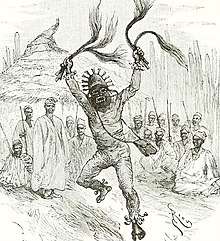Dominican Vudú
Dominican Vudú, also known as Las 21 Divisiones (21 Divisions), is a syncretic religion of Caribbean origin which developed on the island of Hispaniola.
| Dominican Vudú | |
|---|---|
| Type | Syncretic |
| Classification | Voodoo |
| Region | Dominican Republic and Dominican diaspora |
| Origin | Unknown Colonial Hispaniola |
| Part of a series on Vodun related religions called |
| Voodoo |
|---|
 |
|
Beliefs |
|
Deities
|
Beliefs
Dominican Vudú is composed of three main divisions and an annexed extra: Rada Division also known as the white or sweet division, whose spirits are of African origin (usually Fon, Ewe and Nago spirits); the Petro Division also known as the fire or bitter division (mostly of Bantu origin spirits); the Gede Division also called black division (whose spirits deal with death and the ancestors); and lastly the Native American Division also called the water division, whose spirits are of Pre-Columbian origin (usually refers to Taíno ancestral spirits of the island). Most spirits are syncretized with a catholic saints image. These are some of the main features that distinguishes Dominican Vudú from other forms of Vodoo. Some major deities venerated in Dominican Vudú include:
- Anaisa Pye, the loa of love and happiness. She is syncretized with Saint Anne. Her feast day is July 26.[1]
- Belie Belcan, the loa of justice and protection against demons. He is syncretized with Saint Michael the Archangel. His feast day is September 26.[1]
- Candelo sé Difé, Loa of fire, also a warrior and protector spirit. Considered to be one of the Ogou, syncretized with Charles Borromeo. His feast day is November 4.[1]
- Santa Marta Dominadora, or Filomena Lubana, the loa responsible for dominion over men. She is syncretized with Saint Martha. Her feast day is July 29.[1]
- Ogun Balenyo, the loa of warriors and soldiers. He is syncretized with Santiago. His feast day is July 25.[1]
- Baron, the loa of death. He is syncretized with San Elías. His feast day is November 2.[1]
- Metresili, the loa of love, beauty and wealth. She is syncretized with the Mater Dolorosa.
Music
Dominican Vudú music uses Afro-Caribbean percussion, a lot of times it is played with drums popularly known as "Atabales or Palos", which are of Kongo origin; along with it a Guira (metal scraper). The drummers are known as "Paleros", the ceremonies which they perform are usually referred to as "Fiesta de Palo" or "Maní". Some of the most popular artists to record this music are Enerolisa Nuñez and Bembesito.
Characteristics
Dominican Vudú is practiced through a Tcha-Tcha (“maraca” – which means rattle) lineage.[2] In Haiti, Vodoo has come about and become more popular through another lineage known as the Asson. However, before the Asson, the Tcha-Tcha lineage was the prominent lineage in Haiti. Thus the Tcha-Tcha lineage is one of the oldest lineages within the Vodou tradition all over the island.[2]
Dominican Vudú practitioners are often called "Caballos”, "Brujos" or "Servidores" but they are also known as Papa Bokos and Papa Loa (masculine); and Mama Mambos and Mama Loa (feminine). One who has obtained this title has gone through the last and highest level of initiation that can take anywhere between 3 and 9 days and nights as well as have spent a time working for the community.[2]
Differences with Haitian Vodou
Dominican Vudú is less uniform in comparison to the popularly known Haitian lineage called "Assogwe". There is much regional variation in the Dominican Republic and parts of Haiti, one will still surely find a base structure throughout the island that defines and connects all lineages. Altars or shrines range from shacks, to compounds, or even dedicated temples. There is also variations in how ceremonies are conducted or how "caballos" (horse of the spirit) may mount a specific Loa. Differences depend on lineage and or region of practice no matter if in Haiti or the Dominican Republic. It is said that Vodou on the island is a big tree with many branches.
References
- Tejeda Ortiz, Dagoberto, 1940- (1995). Religiosidad popular dominicana y psiquiatría. [publisher not identified]. OCLC 35839523.CS1 maint: multiple names: authors list (link)
- Las 21 Divisiones ~ Dominican Vodou